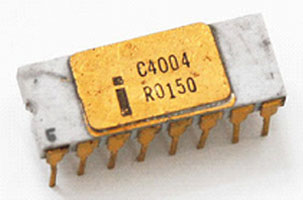In 1971, Intel 4004 was released by Intel Corporation. Intel 4004 is a 4-bit central processing unit (CPU) It was the first commercially produced microprocessor and the first in a long line of Intel CPUs. Small computers with varying amounts of memory and I/O facilities could be built with a 4004 microprocessor, the 4001 ROM, 4002 RAM, and 4003 Shift Register. 4004 microprocessor, the 4001 ROM, 4002 RAM, and 4003 Shift Register constituted the four chips in the Intel MCS-4 chip set. To design Intel 4004, a sheet of Rubylith is physically cut into thin strips to lay out the circuits to be printed, a process made obsolete by current computer graphic design capabilities.
The maximum clock rating of intel 4004 is 740kHz. Its Instruction cycle time is a minimum of 10.8 μs i.e 8 clock cycles/machine cycle. Its instruction execution time is 1 or 2 machine cycles which is 46250 to 92500 instructions per second.4004 have separate program and data storage. in 4004, with its need to keep pin count down, there are 12-bit addresses, 8-bit instructions and4-bit data words. It can directly address 640 bytes of RAM, stored as 1280 4-bit characters, and Organized into groups. it can directly address 32,768 bits of ROM which is equivalent to 4096 8-bit words. it contained 46 instruction sets, of which 41 are 8 bits wide and 6 are 16 bits wide. it contains 16 registers in register set each of 4 bits.
The internal subroutine stack is 3 levels deep. a 4004 with a single 256-byte 4001 program ROM is the minimum system specification described by Intel. thanks to the 4004’s large number of onboard index register there is no explicit need for separate RAM in minimal complexity applications which represent the equivalent of 8 × 8-bit characters. the various other support chips start to become useful as project complexity increases. There are in total 2250 transistors in Intel 4004. 16-pin DIP package is used and sockets of DIP 16.
In 1974, the successor of Intel 4004 was invented. The successor of the Intel 4004 was Intel 4040 microprocessor. The 4040 employed a 10 μm silicon gate enhancement load PMOS technology, which was made up of 3,000 transistors. It could execute approximately 62,000 instructions per second. General performance, bus layout, and instruction set were identical to the 4004. The main improvements were done in the addition of extra lines and instructions to recognize and service interrupts and hardware Halt/Stop commands. To handle nesting of several subroutines and/or interrupts an extended internal stack and general-purpose Index register space, plus a doubling of program ROM address range.
